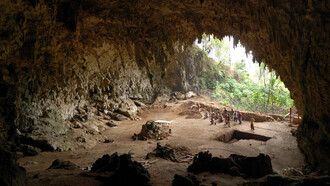Today we met Caroline Gallois who has just opened her new show Zona d’Ombra, at the Galleria Immaginaria Arti Visive in Florence, Italy. The show consists of 16 canvases as well as drawings and paintings on paper. We took this opportunity to ask her a few questions.
Your painting has gone through many phases, beginning in Mexico and the United States with powerful, intense colours. What led you to produce these very delicate canvases, with their pale colours, dominated by shades of white and grey?
I had a chance to work in Mexico City for a year starting in June 1979 at the Mexican Ministry of Agriculture. It was there that I discovered the beauty of the landscape together with Mexican art and culture, murals…and a passion for painting. I had never painted before, having studied political and economic sciences in Paris. It was at the Museum of Modern Art that I fell in love with Mexican art. I discovered the murals of Diego Rivera, Siqueiros, and others, and the painting of Frida Kahlo, who was so passionately involved in political and social issues. Then I went on a four month ‘hippie’ tour around Latin America. During the trip I began to draw, and when I got back to Mexico, I enrolled at the Esmeralda school of art where Frida had taught many years before. There I studied drawing, working a lot from models; in the evenings at home I did ink drawings. In September 1985 there was the tragic earthquake of Mexico City. I was terrified, and transferred to New York, where I began working for a French company. In New York I discovered abstract expressionism - Willem de Kooning, Franz Kline, Hans Hofmann, Jackson Pollock – and was swept off my feet. That was when I began to use oil on large canvases and to bring colour into my paintings, using broad brushstrokes of colour for the backgrounds - especially greys and blues, with patches of yellow and red.
How important is drawing in your most recent works, which contain some features of collage and use various kinds of materials?
Drawing has always been crucial for me both as a method of observation and a practice of meditation. During my New York period I also studied perspective with my architect husband and began to introduce depth into my drawings. I was invited to take part in an important exhibition on the problem of the destruction of tropical forest: I painted a huge yellow canvas called Andropolis, where monkeys, deprived of their trees, are shown hanging from lines painted across the surface of the picture. It was this painting that first led me to reflect on the conflict between the natural and the artificial, a theme that still informs my work. Then I enrolled in the printmaking course at the Art Students League of New York, where I learnt soft-ground etching on metal plates. Etching radically affected my kind of painting, which became more abstract. When I came back to Italy with my husband I transferred the technique of soft-ground etching into my oil paintings, as well as using encaustic techniques and exploiting materials like plastic mesh to symbolize artificiality in contrast with human figures, which for me stand for naturalness.
Does the title of your show, Zona d’Ombra, shadow-zone, have a particular meaning for you? One notices the presence in a number of paintings of human figures in filigree, emerging slowly into sight like ghosts from the past.
The depiction of human figures is an essential aspect of my paintings. Yes, they are ghosts, but they also represent the reality of us humans, the only animals on this planet able to express our dilemmas and existential problems through verbal language as we confront the artificial world that surrounds us. Today, due to industrialization, we have entered a phase of global warming. Glaciers are melting, sea temperatures rising. It’s the eternal dilemma of Nature vs. Culture…
Earlier paintings by Caroline Gallois are reproduced in the volume Gallois by Giuliano Serafini, Edizioni Polistampa, Firenze.















